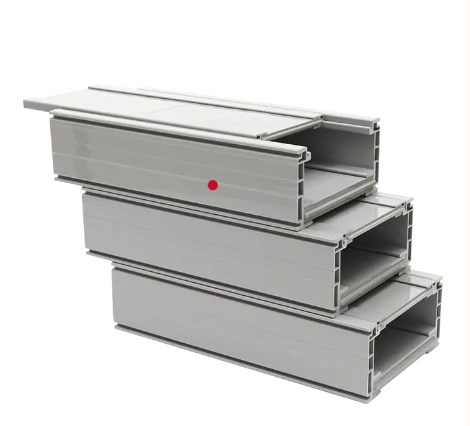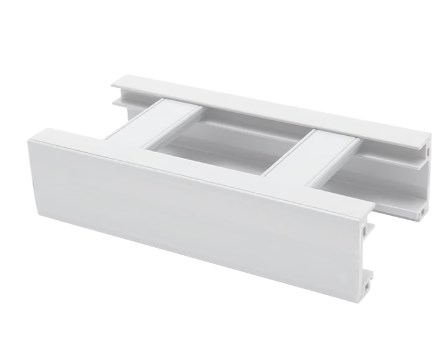In modern industry and construction, cable trays have become essential infrastructure. PVC cable trays, with their unique material advantages and reliable performance, are gradually becoming the preferred cable management system. With the rapid development of industrial automation, smart buildings, and data centers, the demand for cable laying continues to increase. PVC cable trays, with their superior safety and durability, are demonstrating their unique value in numerous cable laying projects.
Material Characteristics and Technical Advantages of PVC Cable Trays
PVC cable trays are made of high-quality polyvinyl chloride (PVC), offering corrosion resistance, flame retardancy, and excellent insulation properties. In power systems, cable trays not only carry cables but also provide management and protection for cable routing. PVC's unique chemical stability allows it to withstand long-term use in humid, acidic, alkaline, and mildly corrosive environments without aging. This provides strong protection for cable laying in factory workshops, underground pipeline corridors, and coastal areas.
PVC cable trays are also lightweight, reducing labor and construction costs during installation and maintenance. Its excellent insulation properties effectively prevent electrical safety risks associated with conductive metal cable trays, ensuring the long-term stable operation of power systems. Compared to metal cable trays, PVC cable trays offer significant advantages in fire resistance, chemical resistance, and impact resistance, making them widely used in demanding environments.

PVC Cable Tray Applications in Different Environments
PVC cable trays are widely used in industrial production, data centers, and commercial buildings. In industrial environments, cable trays must withstand high humidity, chemical corrosion, and mechanical shock, and PVC cable trays' corrosion and impact resistance perfectly meet these requirements. In data centers and communications rooms, PVC cable trays' insulation and fire resistance provide a secure solution for high-density cabling. Its flexible design and diverse structures also facilitate cabling planning and management.
In construction, PVC cable trays are often used in conjunction with power, communications, and low-voltage systems. Through rational cable tray layout, neat, aesthetically pleasing, and safe wiring is achieved. Modern buildings are increasingly demanding in terms of wiring management. PVC cable trays' modular design and flexible wiring capabilities enable scientific planning during the construction design phase and facilitate subsequent maintenance.
Installation and Maintenance Advantages of PVC Cable Tray
During installation, PVC cable tray is lightweight, cuttable, and easy to process, allowing it to quickly adapt to changes in site layouts. The cable tray's connectors, brackets, and support system are all made of high-strength materials, ensuring overall structural stability. Compared to metal cable trays, PVC cable trays require no additional anti-corrosion treatment and are immune to the rusting issues common to metal cable trays, thus reducing long-term maintenance costs.
Regarding maintenance, PVC cable trays have a smooth surface that resists dust and impurities, making cleaning and maintenance less labor-intensive. They can be quickly disassembled and assembled for line maintenance or cable additions, offering enhanced flexibility. This ease of maintenance contributes positively to improved power system operational stability and maintenance efficiency.
Development Trends and Market Prospects of PVC Cable Tray
With the widespread adoption of green building concepts and the advancement of intelligent power systems, the application prospects of PVC cable trays are expanding. The development of new environmentally friendly materials and high-performance polyvinyl chloride (PVC) has continuously improved cable trays' heat resistance, corrosion resistance, and flame retardancy. Furthermore, the promotion of modular, standardized, and intelligent design has made PVC cable trays more competitive in terms of construction efficiency and system integration.
In terms of market demand, demand for PVC cable trays continues to grow in industrial parks, data centers, rail transit, and large-scale construction projects. The power system's high requirements for safety, reliability, and long-term durability provide a stable market for PVC cable trays. Furthermore, the integration of PVC cable trays with intelligent power management systems is driving their application in future smart grids and smart buildings.

Due to their excellent material properties, ease of installation, and excellent maintenance, PVC cable trays have become an irreplaceable infrastructure in modern power systems. Their performance in diverse application scenarios, including industrial, construction, and data centers, fully demonstrates their combination of safety, cost-effectiveness, and environmental friendliness. With technological advancements and growing market demand, PVC cable trays will continue to play a core role in cable management, providing a solid foundation for the stable, efficient, and safe operation of power systems.
Recommended News